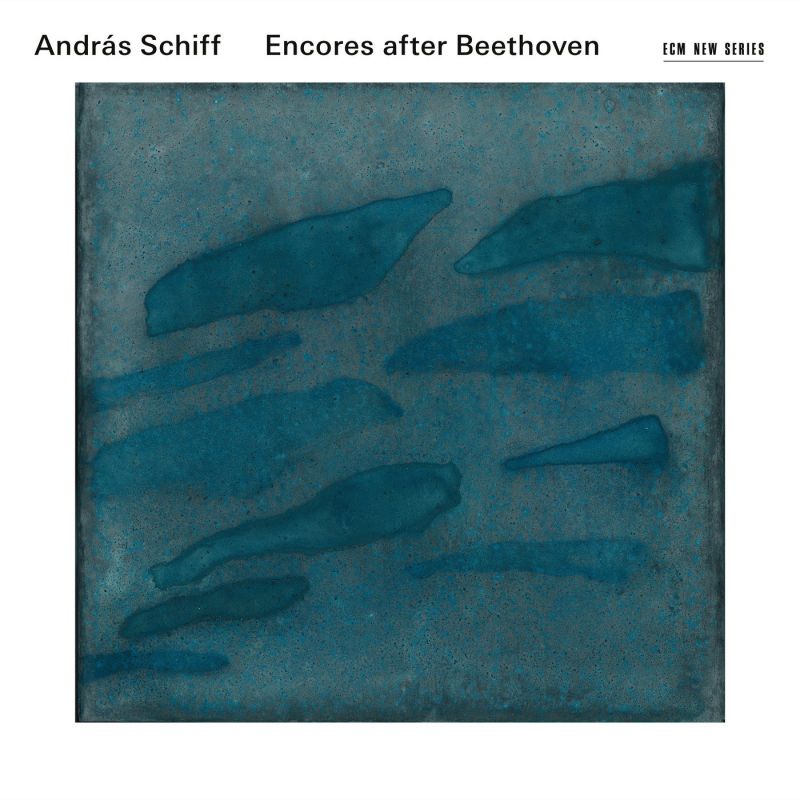Encores After Beethoven
View record and artist detailsRecord and Artist Details
Composer or Director: Joseph Haydn, Wolfgang Amadeus Mozart, Franz Schubert, Johann Sebastian Bach
Genre:
Instrumental
Label: ECM New Series
Magazine Review Date: 02/2017
Media Format: CD or Download
Media Runtime: 52
Mastering:
DDD
Catalogue Number: 481 4474

Tracks:
| Composition | Artist Credit |
|---|---|
| (3) Klavierstücke, Movement: No 1 in E flat minor |
Franz Schubert, Composer
András Schiff, Piano Franz Schubert, Composer |
| Allegretto |
Franz Schubert, Composer
András Schiff, Piano Franz Schubert, Composer |
| Gigue |
Wolfgang Amadeus Mozart, Composer
András Schiff, Piano Wolfgang Amadeus Mozart, Composer |
| Sonata for Keyboard No. 32 |
Joseph Haydn, Composer
András Schiff, Piano Joseph Haydn, Composer |
| Ungarische Melodie |
Franz Schubert, Composer
András Schiff, Piano Franz Schubert, Composer |
| (6) Partitas, Movement: No. 1 in B flat, BWV825 |
Johann Sebastian Bach, Composer
András Schiff, Piano Johann Sebastian Bach, Composer |
| (6) Partitas |
Johann Sebastian Bach, Composer
András Schiff, Piano Johann Sebastian Bach, Composer |
| (Das) Wohltemperierte Klavier, '(The) Well-Tempered Clavier, Movement: B flat minor, BWV867 |
Johann Sebastian Bach, Composer
András Schiff, Piano Johann Sebastian Bach, Composer |
Author: Stephen Plaistow
The delightful essay in the booklet is by Schiff himself. What to play after an evening of, say, five Beethoven sonatas? Nothing, many pianists would insist. And Schiff is in the ranks of those who, after the last Sonata of all (C minor, Op 111), would regard the addition of anything other than silence as a terrible error of judgement. Yet while not minded to bully people to think as he does, he feels with a why-not attitude that there’s no reason to deny an enthusiastic public a few more offerings provided they’re related to the previously heard sonatas. Not trifles of course, and not too many, but something.
They range in length and scope here from Mozart’s little Gigue in G major, K574 (1'42" and so treacherous to play) to Haydn’s two-movement Sonata in G minor (No 44 in Hoboken) that has prompted the attention of several great players, Sviatoslav Richter included (13'37", including all repeats). As a makeweight to Beethoven’s two Op 49 Sonatas, designed to be within the reach of amateurs and always included in cycles of the 32 (but where?), it’s an inspired choice. So little is vouchsafed by Haydn as to dynamics and expression, and yet this sonata is clearly an exceptional inspiration for an interpreter with Schiff’s insights. Listen to him, and indulge me please for banging on about Haydn’s piano music yet again.
As he suggests, playing Beethoven’s Andante favori within hailing distance of the Waldstein Sonata – it was originally conceived as the Sonata’s middle movement – isn’t a bad idea. Nor is the B flat minor Prelude and Fugue from Book 1 of Bach’s ‘48’ a contentious choice as an envoi to the Hammerklavier Sonata. The ‘48’ was Beethoven’s bible, as it had been for Mozart and has been for every composer since. Schiff would like us to accept that his other Bach pieces and especially his three Schubert items are also closely related to the Beethoven given just before. If you know the sonatas well and are perhaps a keen player yourself, listen with surprise and delight to the connections, which will assuredly be more acute if you have the music under your fingers. Don’t worry, however, if you haven’t. Schiff regards the public as ‘a vitally important part of the proceedings’ and wants to share the music with all of us.
He tells a story against himself when, aged 23, on his debut at the Vienna Musikverein, he returned to the stage after performing Bartók’s Third Concerto with János Ferencsik and played something of Haydn. ‘Young man’, said Ferencsik, waiting in the wings, ‘mark my words. There is nothing worse than a prematurely given encore.’ Advice Schiff says he has never forgotten. Did you ever hear the piano sound like a cimbalom? For a last delectable sample of his ‘documents of a long journey’, let me suggest Schubert’s Hungarian Melody in B minor, D817. These days he never returns to his homeland and fulminates against it. How lucky we are to have him here.
Discover the world's largest classical music catalogue with Presto Music.

Gramophone Digital Club
- Digital Edition
- Digital Archive
- Reviews Database
- Full website access
From £8.75 / month
Subscribe
Gramophone Full Club
- Print Edition
- Digital Edition
- Digital Archive
- Reviews Database
- Full website access
From £11.00 / month
Subscribe
If you are a library, university or other organisation that would be interested in an institutional subscription to Gramophone please click here for further information.




